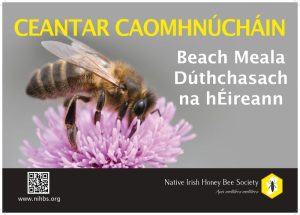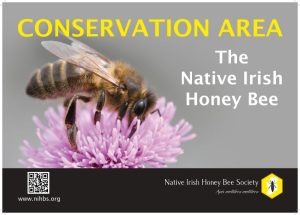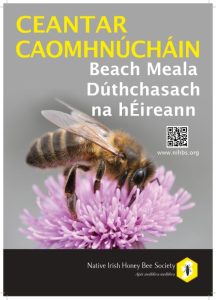Native Irish Honey Bee Society
Latest NIHBS News
Irish times letter with comment on ‘Give Bees a Chance’ article
Advance Science Nosema Workshop, Galway, 8th August
NIHBS mentioned on RTE
Insecticide Alters Honey Bees’ Genes, New Study Shows
Connemara Beekeepers Queen Rearing workshop 7th July
Time to give bees a chance
Available to Purchase
“The Native Irish Honey Bee, Apis mellifera mellifera” focuses exclusively on the native Irish honey bee, featuring narratives on its evolution, genetics, history and conservation, with practical “How-to” sections on bee improvement, plus real-life stories from commercial beekeepers. Its aims are to increase awareness of and appreciation for the precious resources imbued in the native black honey bee, to encourage beekeepers to choose native Irish honey bees and to discourage the buying and importation of non-native honey bees.


NIHBS Conference 2024
Join us at the Athlone Springs Hotel on Friday, March 1st, and Saturday, March 2nd, for the Native Irish Honeybee Society Conference. This exciting event will feature presentations and discussions on the latest research, techniques, and challenges facing beekeepers and honeybee conservation in Ireland.
Attendees will have the opportunity to learn from experts in the field, network with fellow beekeepers, and explore the latest products and services available to support the honeybee industry.
Don’t miss out on this important event – purchase your tickets today! Tickets can be purchased online by using the button below. We look forward to seeing you at the conference 2024!
Become a Patron of NIHBS
By becoming a Patron of the Native Irish Honey Bee Society, you’re not just supporting a cause; you’re investing in the future of our environment, agriculture, and the delicate balance of the Irish ecosystem. Your contribution aids in the preservation of a subspecies integral to the biodiversity of Ireland. You’re not just supporting the bees; you’re becoming a vital part of the community dedicated to preserving and celebrating the incredible Native Irish Honey bee. You can become a patron for as little as €1 – if you are comfortable paying more simply adjust the volume.
Thank you for your support!

Interested in setting up a NIHBS Conservation Area?
Setting up a conservation area for our Native Honey Bees is a crucial step towards preserving their population and ensuring their survival for generations to come. We hope you will consider joining us in this important mission by learning more about the Native Irish Black Bee and the steps you can take to help protect them.
- NIHBS Conservation Areas are areas of land, gardens or wild spaces where there is an agreement not to place hives, or allow colonies of, non-native honey bees.
- NIHBS Conservation Areas are designed to be “safe havens” for our localised native honey bees (Amm). As more of these CA’s are set up, essential “Corridors of Conservation” are being created throughout the island of Ireland.
- These corridors will provide safe spaces for local bees and for effective native honey bee queen rearing and help to prevent further hybridisation and disease brought about through the importation of non-native honey bees.
- We currently have nearly 240 of these – NIHBS Conservation Areas are growing in number at an ever increasing rate. Across the island of Ireland people are excited that they can help do something meaningful to help save our Native Irish Honey Bee.
- Any interested Person or Organisation can volunteer to create a NIHBS Conservation Area (CA). You may already keep or look after native Irish honey bees but there is no requirement to actually have honey bees, be a member of a Beekeepers Association, or have an Apiary.
- You can learn more about the efforts of some of our NIHBS CA’s by reading Bio’s listed on, nihbs.org, Whatwedo/Conservation/Bios
Drop our Conservation Area Officer an email by clicking the “Find Out More” Button on your right. Tell us a little about the proposed location and layout of the CA, Eircode/Postcode and any other information you think relevant for NIHBS to consider.
Signage for NIHBS Conservation Areas
- Professional standard signs, are available in English or Irish. They are only available to declared NIHBS Conservation Areas. Should you need more information about NIHBS Conservation Areas refer to the guidance details on our website homepage, nihbs.org, or send an email to nihbs.conservation@gmail.com
- The initial batch of signs are supplied at no charge but we do ask for Photos once the signs are erected on site.
- Where additional signs are required, the Euro price list shown here applies. Just ask our Conservation Area Officer for availability and an invoice, nihbs.conservation@gmail.com
| Size | Price for 1 | Price for 2 | Price for 3 | Price for 4 |
|---|---|---|---|---|
| A4 | €8.50 | €15.50 | €22.00 | €30.00 |
| A3 | €13.00 | €23.00 | €34.00 | €40.00 |
| A2 | €25.00 | €45.00 | €65.00 | €85.00 |




Thank you very much for your support!
About NIHBS
The Native Irish Honey Bee Society was established to promote the conservation of Apis mellifera mellifera throughout the island of Ireland. The Society strives to raise public awareness of our native honey bee and its importance, and acts in an advisory capacity to groups and individuals wishing to promote and preserve it.

What Our Native Honey Bee Looks Like
Apis mellifera mellifera (aka European dark bee) can be distinguished from other subspecies by its stocky body, overall dark coloration, plus abundant thoracic and sparse abdominal hair, which is brown. There can be heavy dark pigmentation of the wings. Overall, when viewed from a distance, these bees should appear blackish or rich dark brown.

Bee Improvement
As part of our conservation mission, NIHBS advocates that Irish beekeepers buy native bees. To that end, NIHBS is affiliated with multiple bee breeding groups located around the country. Find out more about them by clicking the button below.


